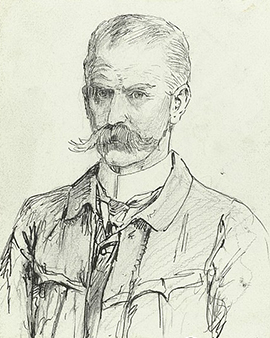


In the vibrant streets of 19th century Amsterdam, the curtain was raised on an enchanting story of art. On September 18, 1858 Jan Hoynck van Papendrecht saw the light of day, destined to enrich the path of Dutch military art. But in this story is interwoven not only the fate and talent of the artist himself, but also the influences of his father, John Cornelis Hoynck van Papendrecht, who passed on to him the legacy of drawing and painting.
Van Papendrecht's journey into the world of art took him from business school in Amsterdam to the prestigious Royal Academy of Fine Arts in Antwerp, encouraged by Charles Rochussen, a close confidant of his father. Munich provided him with another stage to hone his skills before returning to Amsterdam. Here he not only continued his artistic career, but also found happiness in love and married Johanna Philippa van Gorkom. Together they moved around the Netherlands, from Amstelveen to Rheden, before finally settling in The Hague, where van Papendrecht remained until his last breath in 1933.
The beginnings of his career shone brightly when he published his first drawings in the magazine "Eigen Haard" in 1885. But what followed was more than an impressive body of work. Not only did he become known as an illustrator in the magazine "Elsevier," but he also inspired readers with his contributions to the history of the Dutch artillery corps. But if you think "art print" means only two-dimensional works, you are mistaken. Van Papendrecht equally enchanted his admirers with his vivid watercolors, which today are reproduced in art prints at the highest level to do justice to the master.
His oil paintings were more than just paint on canvas. They told stories so powerful that they generated enthusiasm at the 1884 Exhibition of Living Masters in Amsterdam and earned him prestigious awards, some of which were the Gold Medal in Munich and the Silver Medal of the House of Orange.
At the end of his impressive career, crowned by numerous honors and awards, was his appointment as a Knight of the Order of Orange-Nassau. Yet it is his artwork, reproduced as fine art prints, that stands the test of time and keeps his legend alive. A legacy that will live on forever in the hearts of art lovers.

In the vibrant streets of 19th century Amsterdam, the curtain was raised on an enchanting story of art. On September 18, 1858 Jan Hoynck van Papendrecht saw the light of day, destined to enrich the path of Dutch military art. But in this story is interwoven not only the fate and talent of the artist himself, but also the influences of his father, John Cornelis Hoynck van Papendrecht, who passed on to him the legacy of drawing and painting.
Van Papendrecht's journey into the world of art took him from business school in Amsterdam to the prestigious Royal Academy of Fine Arts in Antwerp, encouraged by Charles Rochussen, a close confidant of his father. Munich provided him with another stage to hone his skills before returning to Amsterdam. Here he not only continued his artistic career, but also found happiness in love and married Johanna Philippa van Gorkom. Together they moved around the Netherlands, from Amstelveen to Rheden, before finally settling in The Hague, where van Papendrecht remained until his last breath in 1933.
The beginnings of his career shone brightly when he published his first drawings in the magazine "Eigen Haard" in 1885. But what followed was more than an impressive body of work. Not only did he become known as an illustrator in the magazine "Elsevier," but he also inspired readers with his contributions to the history of the Dutch artillery corps. But if you think "art print" means only two-dimensional works, you are mistaken. Van Papendrecht equally enchanted his admirers with his vivid watercolors, which today are reproduced in art prints at the highest level to do justice to the master.
His oil paintings were more than just paint on canvas. They told stories so powerful that they generated enthusiasm at the 1884 Exhibition of Living Masters in Amsterdam and earned him prestigious awards, some of which were the Gold Medal in Munich and the Silver Medal of the House of Orange.
At the end of his impressive career, crowned by numerous honors and awards, was his appointment as a Knight of the Order of Orange-Nassau. Yet it is his artwork, reproduced as fine art prints, that stands the test of time and keeps his legend alive. A legacy that will live on forever in the hearts of art lovers.
Page 1 / 1






